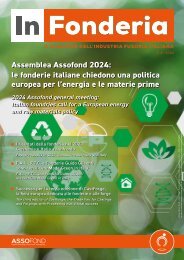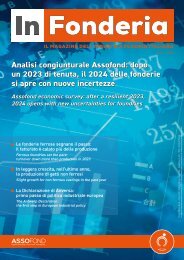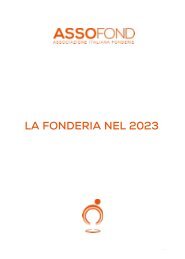In Fonderia 2 2024
Secondo numero del 2024 di In Fonderia
Secondo numero del 2024 di In Fonderia
Create successful ePaper yourself
Turn your PDF publications into a flip-book with our unique Google optimized e-Paper software.
TECNICO<br />
posizione, della quantità e dell’effetto di esse<br />
sulla resistenza e sul comportamento alla fatica<br />
risulta essere più critica che mai.<br />
Una soluzione software che permette di tener<br />
conto delle difettosità del materiale valutando<br />
le reali capacità prestazionali del getto oggi è<br />
di grande importanza per i progettisti. C3P Engineering<br />
Software mette oggi a disposizione<br />
il Cast Designer Performance come strumento<br />
avanzato di simulazione sviluppato appositamente<br />
per questo tipo di studio.<br />
INTRODUZIONE<br />
Il più alto volume di componenti utilizzato dalle<br />
case automobilistiche sono le parti in alluminio<br />
pressofuso. L’uso di questa tecnica si è ampliata<br />
negli anni anche alla produzione dei blocchi<br />
motore, includendo principalmente parti come<br />
testate dei cilindri, telaio e componenti del<br />
gruppo propulsore.<br />
I requisiti molto elevati richiesti per le parti impiegate<br />
nel settore automotive, come durata<br />
della superficie, resistenza del materiale, ecc,<br />
vedono infatti l’impiego della lega di alluminio<br />
pressofuso preferita alla produzione in ghisa,<br />
grazie alle proprietà e caratteristiche metalliche<br />
che essa assume. La bassa densità dell’alluminio,<br />
ad esempio, conferisce una maggiore<br />
mobilità rispetto alla ghisa, fattore molto utile<br />
in spazi più piccoli. L’alluminio non arrugginisce,<br />
per cui l’uso di una sua lega resiste alla corrosione<br />
in maniera molto più efficace, costituendo<br />
notevole vantaggio per l’impiego delle parti in<br />
ambienti difficili. <strong>In</strong>oltre, l’alluminio è più facilmente<br />
riciclabile, rispetto alla ghisa. L’alluminio<br />
ha anche un’elevata conduttività termica ed<br />
elettrica che gli consente di raffreddarsi rapidamente<br />
dopo la sollecitazione termica a cui è<br />
sottoposto.<br />
Getti di alluminio vengono utilizzati comunque<br />
anche in diverse tipologie di parti, con varie applicazioni,<br />
come ad esempio componenti ingegnerizzati<br />
strutturali.<br />
Per contro, uno dei principali inconvenienti<br />
dell’alluminio è che esso non è resistente come<br />
la ghisa ma comunque bisogna sempre tener<br />
presente che l’impiego di un metallo e delle sue<br />
leghe rispetto ad un altro, in un determinato<br />
impiego, presenterà sempre vantaggi e svantaggi<br />
il cui fattore decisivo per la scelta è sempre<br />
legato al comportamento e alle prestazioni<br />
di esso, in risposta alle condizioni di esercizio a<br />
cui è sottoposto.<br />
A correct engineering approach in design<br />
and development must consider the effects<br />
of different defects on the service performance<br />
of cast parts, keeping in mind that<br />
depending on the dimensions and weight of<br />
the cast, knowledge of the position, quantity<br />
and their effect on resistance and stress behaviour<br />
is more critical than ever.<br />
A software solution that allows material<br />
defects to be considered by assessing the<br />
realm performance capabilities of the cast<br />
is of major importance today for designers.<br />
C3P Engineering Software now offers Cast<br />
Designer Performance as an advanced<br />
simulation tool developed especially for this<br />
type of study.<br />
INTRODUCTION<br />
The highest volume of component which is<br />
used by automotive manufacturers is the<br />
Aluminum die cast parts. Nowadays these<br />
components have been expanded to engine<br />
blocks, but primarily it includes cylinder<br />
heads, chassis and power train parts. Die<br />
cast Aluminum alloy replaces the traditional<br />
cast iron engine blocks. For surface durability<br />
and material strength, the automotive<br />
part has a very high requirement. The low<br />
density of aluminum gives it greater mobility<br />
than cast iron, which can be helpful in<br />
smaller spaces. Unlike cast iron, aluminum<br />
does not rust, so it can resist corrosion much<br />
more effectively. This can be a boon in harsh<br />
environments.<br />
Furthermore, aluminum is easy to recycle,<br />
while cast iron must be melted and recast.<br />
Aluminum also has high thermal and electrical<br />
conductivity that allows it to cool down<br />
quickly after compression. Aluminum does<br />
have some drawbacks, primarily that it is<br />
not as durable as cast iron. These aluminum<br />
castings are being used in new part opportunities,<br />
with other applications, for engineered<br />
components in the axle products<br />
and structural components. Both metals<br />
have their benefits and drawbacks, so the<br />
deciding factor should always be the performance.<br />
METHODOLOGY<br />
Typically, in-homogeneities in cast metal<br />
due to porosity or inclusions are not considered<br />
directly in part design. <strong>In</strong>stead, some<br />
<strong>In</strong> <strong>Fonderia</strong><br />
81














